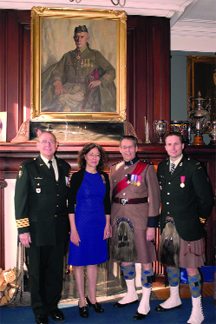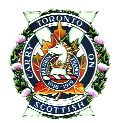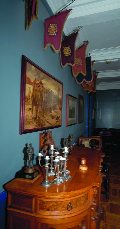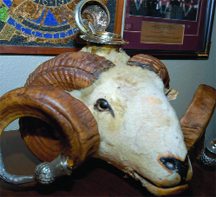By Eric Morse —

Above: Fort York Armoury—the widest wooden latticed roof in Canada.
A storied regiment of the Toronto Garrison is leaving its Downtown home of 77 years for Etobicoke.
On Sept. 12 at 11:30 a.m., led by its pipe band, the Toronto Scottish Regiment will march out of Fort York Armoury for the last time. Lining the parade route will be soldiers in their regimental ceremonial dress from all of the units that are now or have ever been stationed at the armoury.
The regiment will be transported to its new headquarters at Captain Bellenden S Hutcheson VC MC Armoury located near Lakeshore Blvd. and Islington Ave., with an outlying company, the 75th Mississauga, in Mississauga where it has been since 2004.
The new armoury is part of a shared-use training facility with the Toronto Police Service.

The Toronto Scottish Officers’ Mess in its glory days: Senior Officers and guests celebrate New Year’s Day Levee 2009.
You didn’t know Toronto had a garrison? You are probably not alone. The word is redolent of an older time, when cities had fortresses, low things with 5-pointed bastions and many guns. In those days the city gates were closed at sundown, and they underwent a good siege every few decades just to keep things lively. If the garrison units were local citizen militia, their officers and commanders came from the cream of society, and the Garrison Ball was a highlight of the social season.
Toronto hasn’t had a good siege since 1812 but it definitely has a garrison, and the regiments that comprise it are storied indeed, with histories that go back to World War One, the Boer War, and earlier. They belong to the Primary Reserve of the Canadian Forces, they are the ten units of 32 Brigade Group of Land Forces Central Area, and the Toronto Scottish Regiment stands tall among them.
For many years the militia and their part-time soldiers and officers didn’t get much respect from Canadians. To the vast majority, Canadian soldiers were rightfully to be found keeping the peace in places like Gaza or Cyprus, and preferably far out of sight of main street Canada. The reserves were generally disparaged as a pack of Saturday soldiers commanded by insurance men who aspired to be Colonel Blimp.
Like all stereotypes, the caricature has a few seeds in reality. But Canada’s army, except for the (sometimes pathetically small) hard core of professional regular officers and soldiers, has always been an army of part-timers. In South Africa and both world wars, insurance men and lawyers led local battalions of bookkeepers and delivery boys and farmers into battle, and made themselves an international reputation as hardened professional soldiers that the latest generation of reservists is renewing in the dust of Kandahar.

The TorScots crest.
They got the rudiments of their training on Thursday evenings on parade squares like Fort York armoury and weekends on the range at Meaford. The Royal Canadian Military Institute on University Ave. was founded in the years before World War One as a self-help attempt to give the senior officers—businessmen all—some coherent education in what it takes to lead an army.
With considerable added sophistication, that is still very much how things are in the Toronto Garrison. The garrison units do not march off to war together any more—that lesson was learned the hard way in two world wars when entire neighbourhoods of young men might be slaughtered in a single battle. They serve as the foci of basic training and the inculcation of the military way of doing things for the young civilian men and women who may then rotate into the active battalions of the great regular regiments of the Canadian Forces, carrying the name and tradition of their home unit on their shoulder patches as they go.
And the Garrison Ball is still one of the highlights of Toronto’s social season.

A scatter of regimental silver remains on the buffet. The Pipe Banners of each Commanding Officer in turn hang over the ruins of the Officers’ Mess.
In a regiment like the Toronto Scottish (often referred to as “TorScots†but never in the hearing of its officers and men), tradition runs very deep. All ranks are steeped in the lore and heroes of the unit. The lore is in the keeping of the senior warrant officers (full-time reservists) like 25-year veteran regimental Sergeant Major Mike Lacroix, who spend many evenings drilling it into them in the three regimental messes—one for officers, one for warrant officers (aka sergeants) and one for the junior ranks (everybody else).
You might see something like a regimental officers’ mess in a Kipling movie set—or a Harry Potter one—but in very few other places. Dark paneling, massed regimental silver, the portraits of former commanders and of the royal patron—in this case Prince Charles and the late Queen Mother Elizabeth—perpetuate imperial traditions into the present day (you would see similar messes in New Delhi, Rawalpindi, Brisbane or Dar-es-Salaam). Above everything hang the regimental colours.
The more junior messes are less baroque in decoration, but come with their own collections of icons and lack no comforts, including (in the warrant officers’ mess) a ram’s head snuffbox (still allowed in Ontario!) and a mechanical darts scoreboard that Tom Swift would have been proud of. In fact, he probably invented it.
No taxpayer’s dollar maintains the messes: they are kept going by members’ subscriptions and bar sales. Â
There will be changes in the regiment’s new home. There is no longer the square footage to allow for fireplaces, panelling and cabinetry. It will represent a great loss in heritage, as some of the fixtures came to Fort York Armoury in 1933 from their previous home at University Ave. armouries, torn down in 1965 to make way for the courthouse.
In the new armouries, the regimental colours will stand in the entrance to the parade square, where they may be seen (and saluted) by all ranks.

The Ram’s Head snuffbox in the Warrant Officers’ Mess.
RSM Lacroix notes that the return to Etobicoke and Mississauga is in some sense a return to the roots, as the regiment perpetuates the memory of the 75th Mississauga Battalion of World War I. The new armouries are named after Capt. Hutcheson, who was the medical officer of the 75th. (His grandson and great-grandson will be on hand for the dedication.)
More importantly the move also acknowledges a change in demographic. By 2000 it made no sense for the garrison units to be concentrated Downtown when most of the potential recruits are more likely to live in the farther 416 and near-905 areas. Coming years will see further redistribution of units.
Fort York Armoury is unique in itself. Designed by Toronto architects Marani, Lawson and Morris and constructed in 1933. The building features the largest lattice wood arched roof in Canada, spanning 125 feet. According to reliable sources it also boasts a famous collection of roof leaks, pitted floors, mice and occasional leaky toilets directly over one unit commander’s office.
The armoury is currently home to four of the garrison units: the Queen’s York Rangers, the Royal Regiment of Canada, the Toronto Scottish Regiment (Queen Elizabeth the Queen Mother’s Own), and the 709 (Toronto) Communication Regiment plus several thriving cadet units. When the Scottish move out in September, their place will be taken by the Battle School of 32 Brigade Group, which is responsible for training programs.Â
 TheBulletin.ca Journal of Downtown Toronto
TheBulletin.ca Journal of Downtown Toronto

